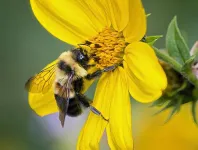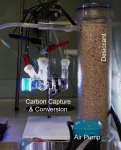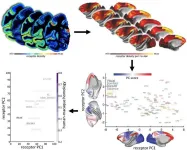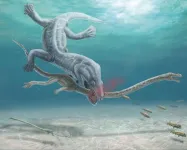(Press-News.org) LOGAN, Utah, June 20, 2023 — A detailed, high-resolution map of the rusty patched bumble bee’s genome has been released by U.S. Department of Agriculture (USDA) Agricultural Research Service (ARS) and U.S. Fish and Wildlife Service (USFWS) scientists, offering new possible approaches for bringing the native pollinator back from the danger of extinction.
Putting together the rusty patched bumble bee genome is part of the Beenome 100 project, a first-of-its-kind effort to create a library of high-quality, highly detailed genome maps of 100 or more diverse bee species found in the United States. Beenome 100 is a collaborative undertaking of ARS and the University of Illinois. The expectation is that this library will help researchers answer the big questions about bees such as what genetic differences make a bee species more vulnerable to climate change or whether a bee species is likely to be more susceptible to a pesticide.
The rusty patched bumble bee (Bombus affinis) is an important pollinator of bergamot (Monarda fistulosa), milkweed, and other wildflowers, as well as crops such as cranberries, plums, apples and alfalfa. But in the last 20 years or so, its population is estimated to have declined by 87 percent.
In 2017, the species was listed as “endangered." Where rusty patched bumble bees were once common across the Upper Midwest and Northeast in 28 states and 2 Canadian provinces, now their range is down to disconnected spots in 13 states and one Canadian province. Among the few places they are still regularly found is around the Minneapolis-St. Paul area of Minnesota and in Wisconsin.
“With the amount of detailed information that we and other researchers now have access to in this newly sequenced genome, we have an opportunity to find a whole different approach to strengthening rusty patched bumble bee populations,” said research entomologist Jonathan B. Uhaud Koch with the ARS Pollinating Insect-Biology, Management, Systematics Research Unit in Logan, Utah.
Koch explained that some of the factors contributing to the decline of rusty patched bumble bees are already known: loss of habitat, reduced variety of nectar sources, climate change, exposure to pesticides, and more pathogens and pests.
While scientists have known the widespread presence of the fungal pathogen Varimorpha bombi (formerly called Nosema bombi) has a detrimental impact on many rusty patched bumble bee populations, Koch was a bit surprised by how much Varimorpha genetic material he found in the bumble bee sample that was used to develop the genome map.
“We used a small piece of abdominal tissue from a single male collected from a nest in Minnesota, which, given the endangered status of the rusty patched bumble bee, seemed like a very good idea,” Koch said. “It’s only with the most cutting-edge equipment that you could resolve an entire genome of 15,252 genes and 18 chromosomes from a tiny bit of one bumble bee.
It turns out about 4.5 percent of the DNA the researchers sequenced came from Microsporidia, the fungal group that includes Varimorpha bombi. “That’s a massive amount of genetic information from the bee tissue sample to be associated with Varimorpha bombi. It demonstrates how pervasive the pathogen is,” Koch said.
“Having this high-quality genome will support the identification of genetic differences between rusty patched bumble bee populations that appear to be doing well versus where they are in decline,” Koch said. “This may give us a handle on identifying the genes that give the more capable population its flexibility to deal with its environment. We may also gain a better understanding of the genetic basis of bumble bee behavior, physiology and adaptation to changing environmental conditions.”
Once the more successful genes for a particular type of local condition are identified, researchers will be able to give a population a boost in the right direction when it comes to restoring the rusty patched bumble bee to an area through captive breeding programs.
This research was funded by ARS and USFWS. The research was published in the journal G3: Genes | Genomes | Genetics [https://doi.org/10.1093/g3journal/jkad119] and the genome is available on the National Center for Biotechnology Information website https://www.ncbi.nlm.nih.gov/assembly/GCF_024516045.1/ .
The Agricultural Research Service is the U.S. Department of Agriculture's chief scientific in-house research agency. Daily, ARS focuses on solutions to agricultural problems affecting America. Each dollar invested in U.S. agricultural research results in $20 of economic impact.
#
END
The face of a 16-year-old woman buried near Cambridge (UK) in the 7th century with an incredibly rare gold and garnet cross (the ‘Trumpington Cross’) has been reconstructed following analysis of her skull. The striking image is going on public display for the first time on 21st June, with new scientific evidence showing that she moved to England from Central Europe as a young girl, leading to an intriguing change in her diet.
The image and artefacts from the mysterious woman’s ...
Weak policies and political ideologies risk jeopardising plans to tackle health and climate change, says Cambridge expert
Efforts to tackle major issues facing the UK, including the nation’s health and climate change, are being hampered because politicians often ignore the existing evidence when setting policies, according to Dame Theresa Marteau, a public health expert at the University of Cambridge.
Writing in the journal Science and Public Policy, Professor Marteau argues that this ‘evidence-neglect’ is a result of incentive structures that encourage politicians to set ambitious policy goals while simultaneously disincentivising ...
1. Low-dose aspirin use associated with 20% increased anemia risk in older adults
Abstract: https://www.acpjournals.org/doi/10.7326/M23-0675
URL goes live when the embargo lifts
An analysis of the ASPREE (ASPirin in Reducing Events in the Elderly) trial found that the use of low-dose aspirin was associated with a 20 percent increased incidence of anemia and decline in ferritin, or blood iron levels, in otherwise healthy older adults. These findings suggest that periodic monitoring of hemoglobin should be considered in older patients taking aspirin. The analysis is published in Annals ...
FU Qiaomei, a paleogeneticist at the Chinese Academy of Sciences (CAS), received the UNESCO–AI Fozan International Prize for the Promotion of Young Scientists in Science, Technology, Engineering and Mathematics (STEM) on June 19 in Paris, France, for her “seminal work on the history of early humans in Eurasia, based on genetic lineage studies, which provides new insights on the early human history of Eurasia and perspectives on the evolution of human health.”
She was one of five young scientists from around the world to receive the prize, alongside researchers from Argentina, Cameroon, Egypt, and Serbia. The laureates were ...
Researchers have demonstrated how carbon dioxide can be captured from industrial processes – or even directly from the air – and transformed into clean, sustainable fuels using just the energy from the Sun.
The researchers, from the University of Cambridge, developed a solar-powered reactor that converts captured CO2 and plastic waste into sustainable fuels and other valuable chemical products. In tests, CO2 was converted into syngas, a key building block for sustainable liquid fuels, and plastic bottles were converted into glycolic acid, which is widely used in the cosmetics industry.
Unlike earlier tests ...
A key challenge in neuroscience is to understand how the brain can adapt to a changing world, even with a relatively static anatomy. The way the brain’s areas are structurally and functionally related to each other – its connectivity – is a key component. In order to explain its dynamics and functions, we also need to add another piece to the puzzle: receptors. Now, a new mapping by Human Brain Project (HBP) researchers from the Forschungszentrum Jülich (Germany) and Heinrich-Heine-University Düsseldorf (Germany), in collaboration with scientists from the University of Bristol (UK), ...
In the age of dinosaurs, many marine reptiles had extremely long necks compared to reptiles today. While it was clearly a successful evolutionary strategy, paleontologists have long suspected that their long-necked bodies made them vulnerable to predators. Now, after almost 200 years of continued research, direct fossil evidence confirms this scenario for the first time in the most graphic way imaginable.
Researchers reporting in the journal Current Biology on June 19 studied the unusual necks of two Triassic ...
Receptor patterns define key organisational principles in the brain, scientists have discovered.
An international team of researchers, studying macaque brains, have mapped out neurotransmitter receptors, revealing a potential role in distinguishing internal thoughts and emotions from those generated by external influences.
The comprehensive dataset has been made publicly available, serving as a bridge linking different scales of neuroscience - from the microscopic to the whole brain.
Lead author Sean Froudist-Walsh, ...
People who owned black-and-white television sets until the 1980s didn’t know what they were missing until they got a color TV. A similar switch could happen in the world of genomics as researchers at the Berlin Institute of Medical Systems Biology of the Max Delbrück Center (MDC-BIMSB) have developed a technique called Genome Architecture Mapping (“GAM”) to peer into the genome and see it in glorious technicolor. GAM reveals information about the genome’s spatial architecture that is invisible to scientists using solely Hi-C, a workhorse tool developed in 2009 to study DNA interactions, reports a new study in Nature Methods by the Pombo lab.
“With ...
Scientists have long struggled to find the best way to present crucial facts about future sea level rise, but are getting better at communicating more clearly, according to an international group of climate scientists, including a leading Rutgers expert.
The consequences of improving communications are enormous, the scientists said, as civic leaders actively incorporate climate scientists’ risk assessments into major planning efforts to counter some of the effects of rising seas.
Writing in Nature Climate Change, the scientists ...






